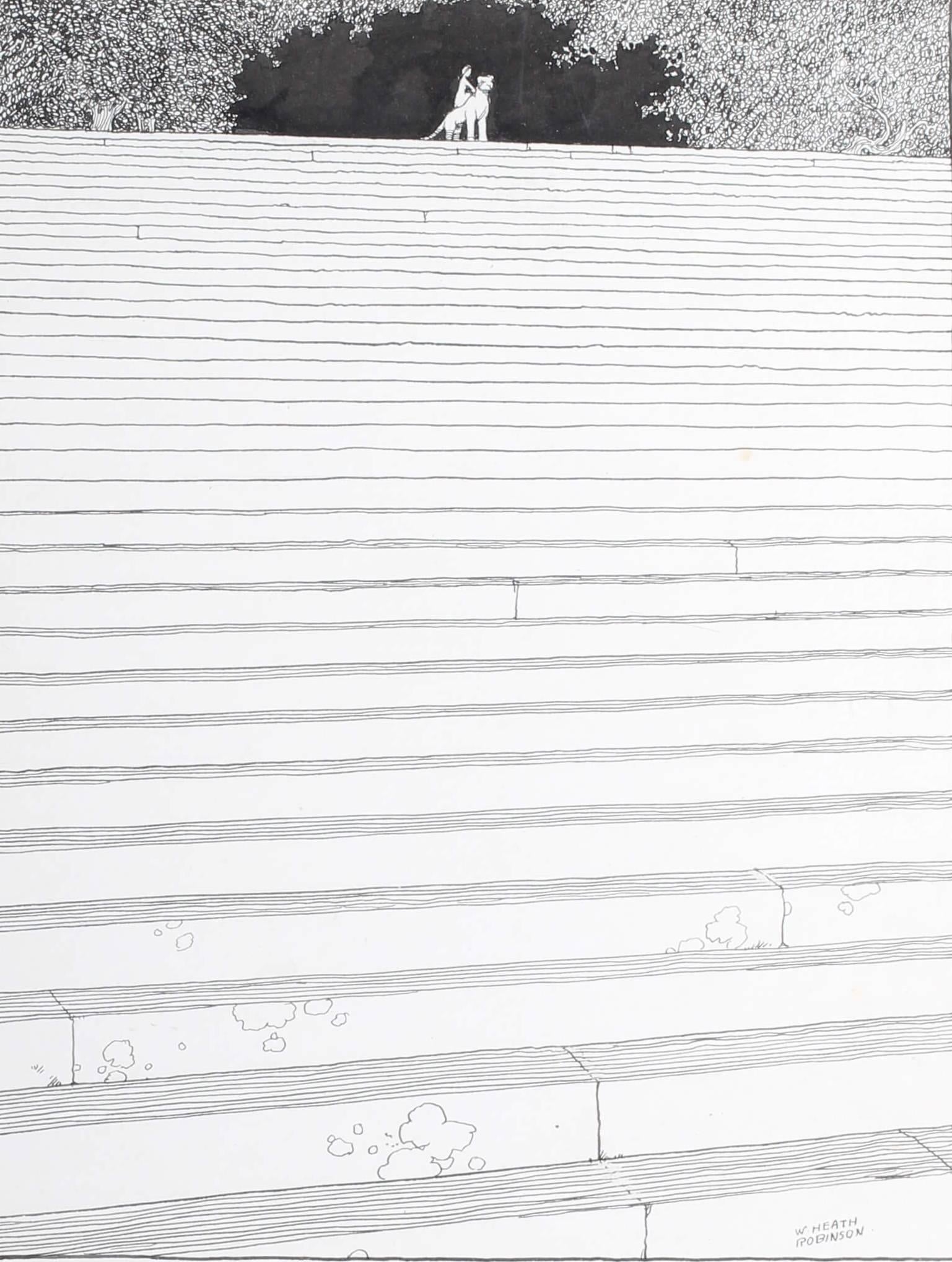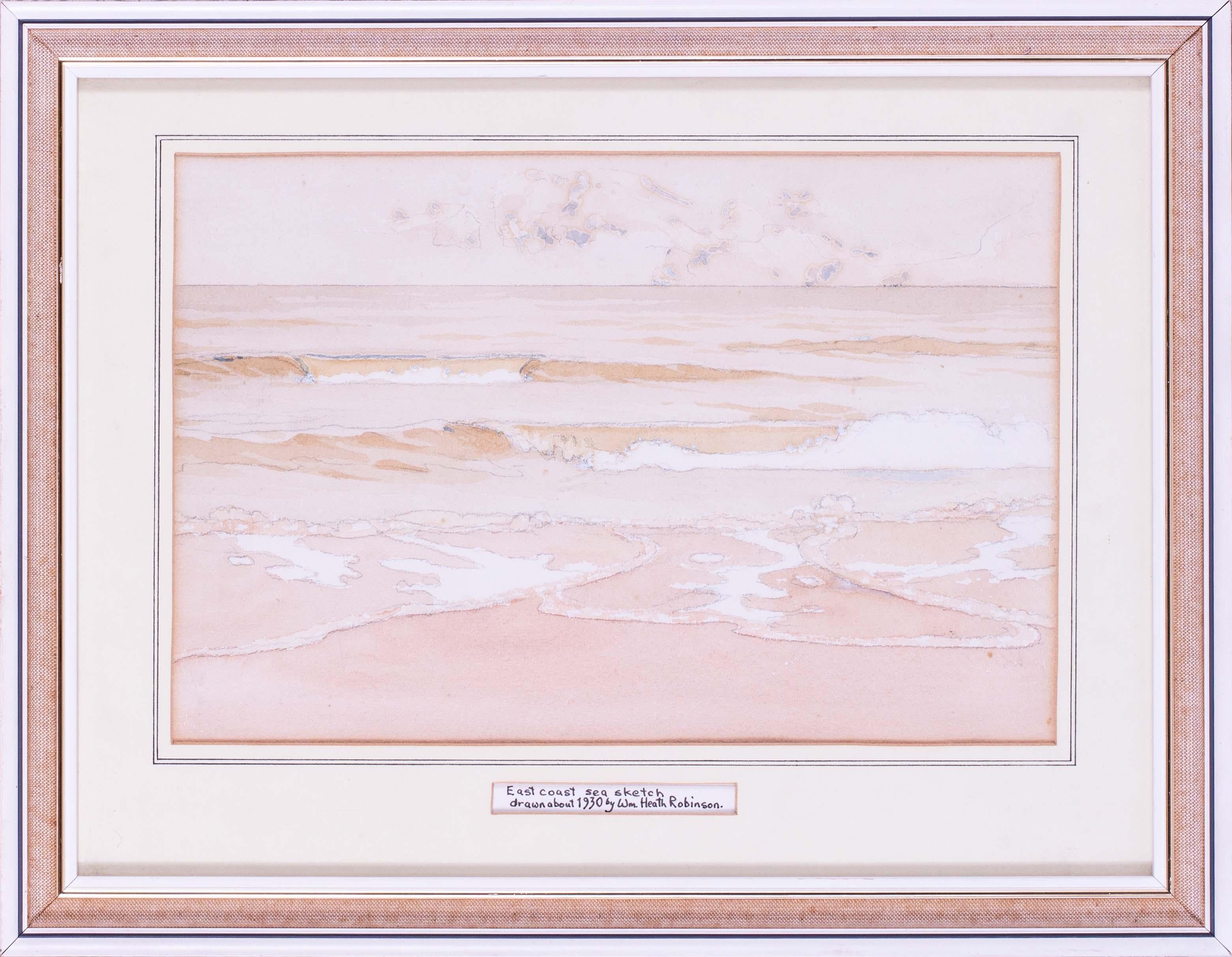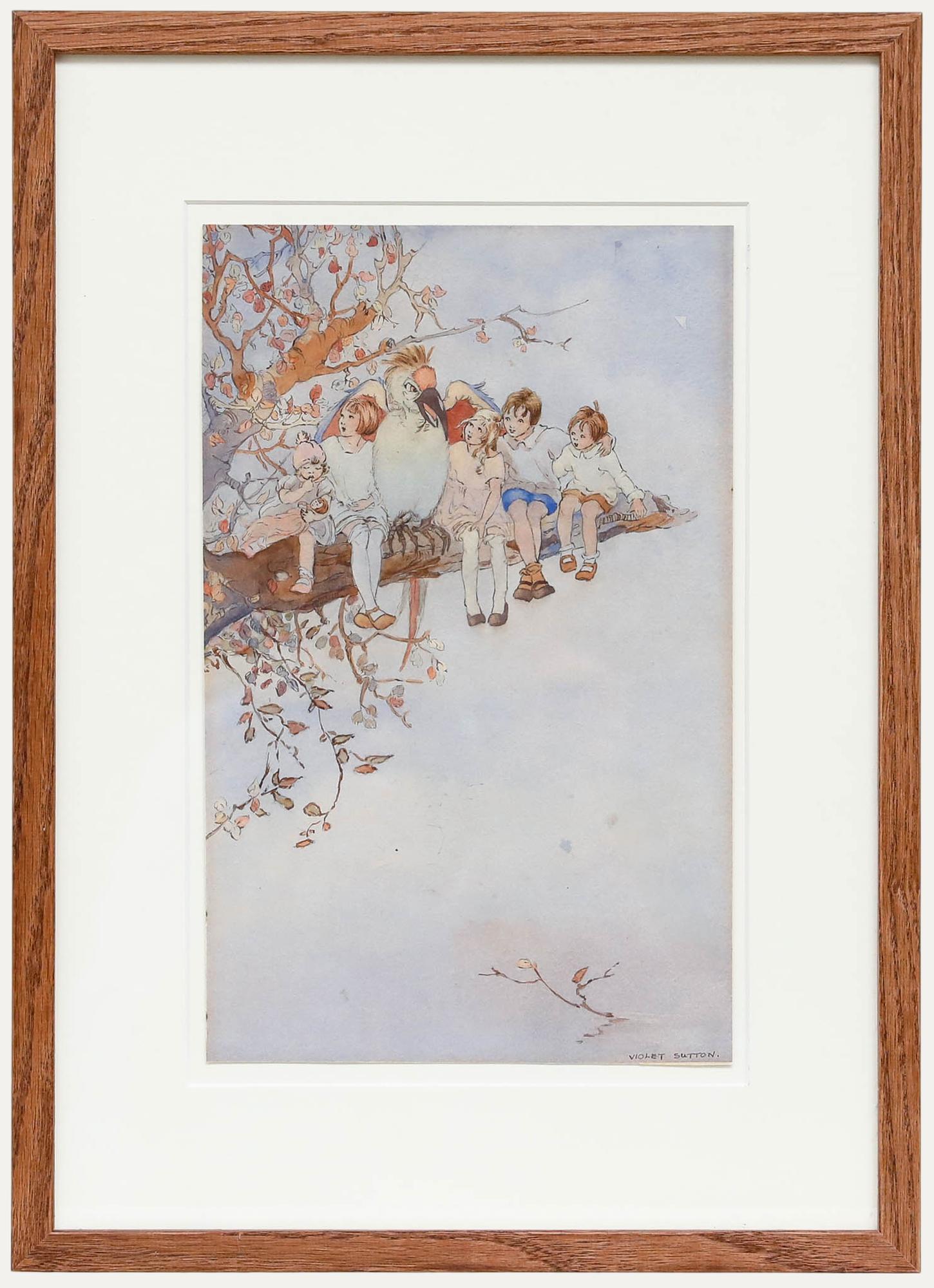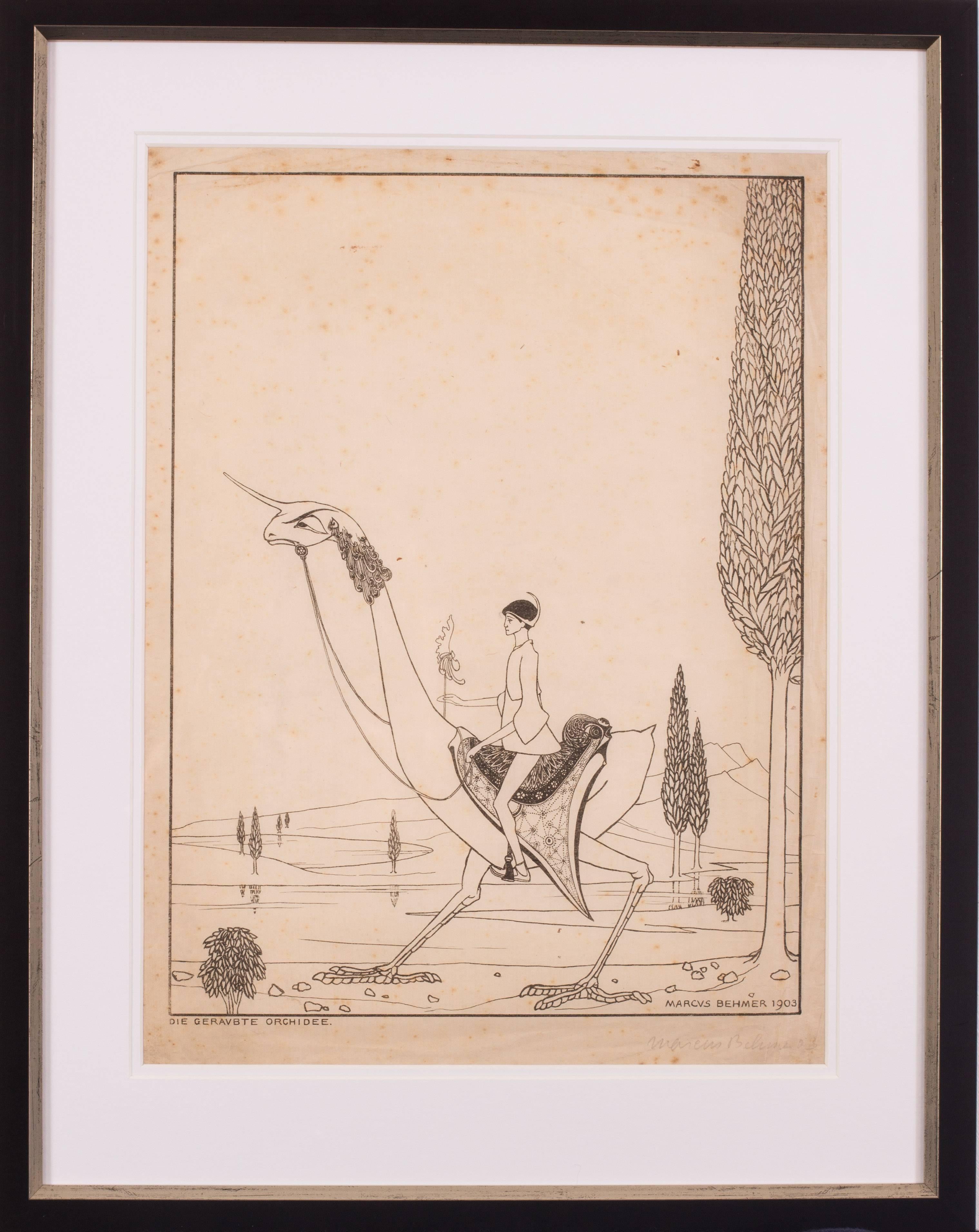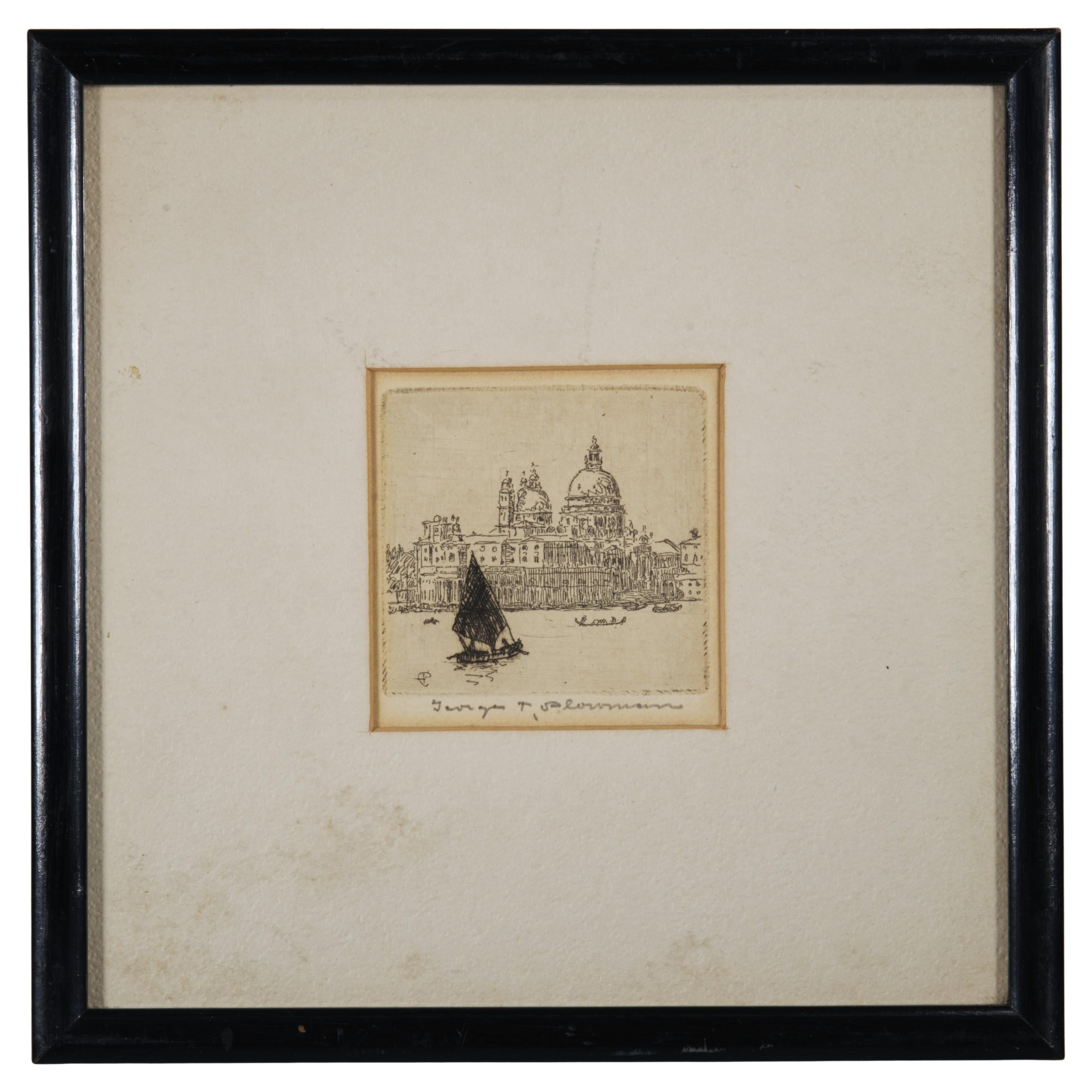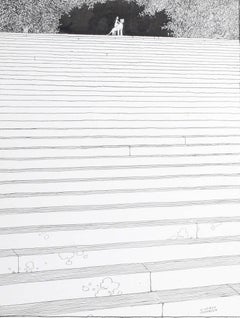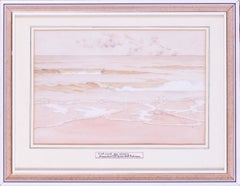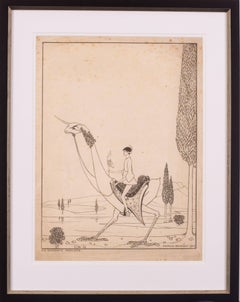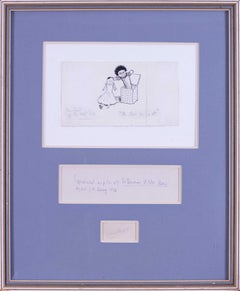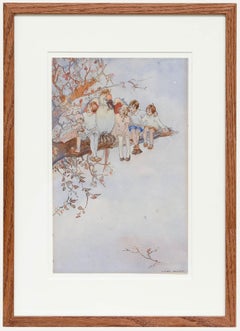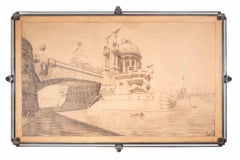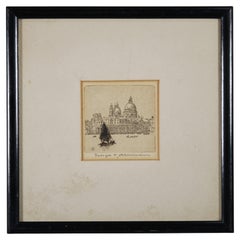Items Similar to William Heath Robinson original drawing, British early 20th Century
Want more images or videos?
Request additional images or videos from the seller
1 of 11
William Heath RobinsonWilliam Heath Robinson original drawing, British early 20th Century
$11,255.84
£8,200
€9,682.15
CA$15,578.75
A$17,348.17
CHF 9,057.88
MX$210,205.28
NOK 114,229.41
SEK 107,784.45
DKK 72,276.11
About the Item
William Heath Robinson (British, 1872 - 1944)
'Boring The First Tunnel With An Early Type Of Rotary Excavator, And The Red Flag', circa 1935 (railway ribaldry was published in this year)
The former signed 'W. Heath Robinson (lower left) and inscribed with title (lower left and right)
The former to mount 14 X 10.1/4in. (35.5 X 26cm.)
The latter 1.1/2 X 8.1/2in. (3.8 X 21.6 cm.)
Literature: Railway Ribaldry, first published by the Great Western Railway, Paddington, 1935.
William Heath Robinson was an English cartoonist and illustrator best known for drawings of ridiculously complicated machines for achieving simple objectives.
During the First World War, he drew large numbers of cartoons, depicting ever-more unlikely secret weapons being used by the combatants. In the UK the term "Heath Robinson" entered popular language during this time as a description of any unnecessarily complex and implausible contrivance. Its continuing popularity was undoubtedly linked to Second World War Britain's shortages and the need to "make do and mend".
In the course of his work, Robinson also wrote and illustrated three childrens books including The Adventures of Uncle Lubin (1902) which is regarded as the genesis of his depiction of unlikely machines.
The inventions he drew were frequently powered by steam boilers or kettles, heated by candles or a spirit lamp and usually kept running by balding, bespectacled men in overalls. There would be complex pulley arrangements, threaded by lengths of knotted string.
One of his most famous series of illustrations accompanied the first Professor Branestawm book written by Norman Hunter. The stories provided a perfect backdrop for Robinson's drawings.
One of the automatic analysis machines built for Bletchley Park during the Second World War to assist in the decryption of German message traffic was named "Heath Robinson" in his honour.
He died in September 1944 during the Second World War and is buried in East Finchley Cemetery.
The Heath Robinson Museum in Pinner opened in October 2016 to house a collection of nearly 1,000 original artworks owned by The William Heath Robinson Trust.
In the Wallace and Gromit movies, Wallace often invents Heath Robinson-like machines, with some inventions being direct references.
- Creator:William Heath Robinson (1872 - 1944, British)
- Dimensions:Height: 33.5 in (85.09 cm)Width: 24 in (60.96 cm)Depth: 2.75 in (6.99 cm)
- Medium:
- Period:
- Condition:Overall in very good condition, slight discolouration of paper. Handsomely framed and mounted behind glass in a gilded composite frame with foliate detail.
- Gallery Location:Petworth, GB
- Reference Number:1stDibs: LU54038503402
About the Seller
4.9
Platinum Seller
Premium sellers with a 4.7+ rating and 24-hour response times
Established in 2010
1stDibs seller since 2017
272 sales on 1stDibs
Typical response time: 2 hours
- ShippingRetrieving quote...Shipping from: Petworth, United Kingdom
- Return Policy
Authenticity Guarantee
In the unlikely event there’s an issue with an item’s authenticity, contact us within 1 year for a full refund. DetailsMoney-Back Guarantee
If your item is not as described, is damaged in transit, or does not arrive, contact us within 7 days for a full refund. Details24-Hour Cancellation
You have a 24-hour grace period in which to reconsider your purchase, with no questions asked.Vetted Professional Sellers
Our world-class sellers must adhere to strict standards for service and quality, maintaining the integrity of our listings.Price-Match Guarantee
If you find that a seller listed the same item for a lower price elsewhere, we’ll match it.Trusted Global Delivery
Our best-in-class carrier network provides specialized shipping options worldwide, including custom delivery.More From This Seller
View AllAn original British 20th Century drawing by British illustrator Heath Robinson
By William Heath Robinson
Located in Petworth, West Sussex
William Heath Robinson (British, 1872-1944)
'The Friendly Dog'
Signed 'W. Heath Robinson.' (lower right)
Pen and ink on paper
11 X 8.1/2in. (28 X 21.7cm.) (excluding frame)
46 x 38cm. (18.1/4 x 15in. (including frame)
Literature: 'Old Time Stories', Constable and Co. 1921, P. 143
William Heath Robinson was an artist and illustrator mainly associated with his gloriously complicated inventions for simple objectives. The name Heath Robinson has become commonplace in the English language as a result to describe anything mechanical that is eccentric, ridiculously complex and ingenious at the same time .
Interestingly one of the automatic analysis machines built for Bletchley Park...
Category
Early 20th Century Animal Drawings and Watercolors
Materials
Paper, Ink, Pen
William Heath Robinson East Coast sea sketch, 1930
By William Heath Robinson
Located in Petworth, West Sussex
William Heath Robinson (British, 1872-1944)
East coast sea sketch, circa 1930
Pencil and watercolour
8.1/2 x 12.3/4 in. (21.7 x 32.3 cm.)
There is an extensive passage regarding the ...
Category
20th Century English School Landscape Drawings and Watercolors
Materials
Watercolor, Pencil
Original early 20th Century German signed lithograph by Marcus Behmer
By Marcus Behmer
Located in Petworth, West Sussex
Marcus Behmer (German, 1879 – 1958)
Die Geravbte orchidee (The robbed orchid), 1903
Signed ‘Marcus Behmer’ (lower right in pencil)
Lithograph on paper
16.1/8 x 12in. (40.8 x 30.5cm.)
It is apparent Behmer is influenced by the work of Aubrey Beardsley, though this work is no less beautiful in its execution. Little is known regarding his connections to Oscar Wilde though he is obviously an admirer and has many similarities with his private life and incarceration in prison. These works were a personal gift to Baron Detlev von Hadeln, the aristocrat and prominent art historian of the age.
Behmer is known to be, since 1903, a member in the first ever homosexual organization in Berlin and was thus probably a part of Adolf Brand’s circle, and may have contributed to Brand’s publication Der Eigene. Until now, few know that Behmer was sentenced in April 1937 by a court in Konstanz to imprisonment for two years, being arrested in Freiburg and at other locations in southern Germany for being a homosexual. At times he was given the opportunity to work as an artist in prison. The works produced in this period are mostly calligraphic designed tablets with Greek text (prayers and Bible quotes...
Category
Early 20th Century Art Nouveau More Prints
Materials
Lithograph
British illustration by EH Shephard, illustrator for Winnie the Pooh
Located in Petworth, West Sussex
Ernest Howard Shephard (British, 1879 – 1976)
The land of the lost toys – ‘Oh that’s you is it’
Inscribed with title (lower edge), and further inscribed ...
Category
20th Century English School Animal Drawings and Watercolors
Materials
Paper, Ink, Pen
Early 20th Century French crayon drawing of a group of young people
Located in Petworth, West Sussex
Edmund Dulac (French, 1882 – 1953)
A welcome refreshment
Black crayon with a touch of white chalk
Signed ‘E Dulac’ (upper right)
8.7/8 x 11 in. (22.5 x 28...
Category
20th Century Academic Figurative Drawings and Watercolors
Materials
Paper, Chalk, Crayon
An early 19th Century drawing by the British pre-Raphaelite artist Lord Leighton
By Frederic Leighton
Located in Petworth, West Sussex
Lord Frederick Leighton (British, 1830-1896)
A very early study of a Medieval Minstrel
pencil on paper
the fragment measures approx. 19.1/2 x 13 in.
(49.5 x 33 cm.)
Provenance: Gifted by Leighton to his cousin Edith Emily Jellicorse, nee Garnham, and thence by descent.
We would like to thank Daniel Robins, the curator at Leighton House for the authenticating this work in full.
Daniel has suggested this study would have been executed when Leighton was studying in Frankfurt
Leighton was born in Scarborough to Augusta Susan and Dr. Frederic Septimus Leighton. He received his artistic training on the European continent, first from Eduard von Steinle and then from Giovanni Costa. According to Daniel Robbins, the curator at Leighton House, This drawing comes from the time Leighton studied under Eduard von Steinle. He then studied at the Accademia di Belle Arti in Florence. From 1855 to 1859 he lived in Paris, where he met Ingres, Delacroix, Corot and Millet.
In 1860, he moved to London, where he associated with the Pre-Raphaelites. In 1864 he became an associate of the Royal Academy and in 1878 he became its President (1878–96). American art critic Earl Shinn claimed at the time that "Except Leighton, there is scarce any one capable of putting up a correct frescoed figure in the archway of the Kensington Museum." His paintings represented Britain at the great 1900 Paris Exhibition.
Leighton was knighted at Windsor in 1878 and was created a baronet, of Holland Park Road eight years later. He was the first painter to be given a peerage.
Leighton remained a bachelor and rumours of him having an illegitimate child with one of his models, in addition to the supposition that Leighton may have been a homosexual, continue to be debated. On his death his barony was extinguished after existing for only a day; this is a record in the Peerage. His house in Holland Park, London has been turned into a museum. It contains many of his drawings and paintings, as well as some of his former art collection including a painting dedicated to Leighton by Sir John Everett Millais. The house also features many of Leighton's inspirations, including his collection of Iznik tiles. Its centrepiece is the magnificent Arab Hall.
Leighton was an enthusiastic volunteer soldier, enrolling with the first group to join the 38th Middlesex (Artists') Rifle Volunteer Corps (later to be known as the Artists Rifles...
Category
19th Century Pre-Raphaelite Figurative Drawings and Watercolors
Materials
Paper, Pencil
You May Also Like
Violet Sutton - Framed Early 20th Century Watercolour, A Magical Adventure
Located in Corsham, GB
Six children and a bird sit together on a branch in this whimsical illustration. Signed to the lower right. Smartly float-mounted in a wooden frame. On paper.
Category
20th Century Figurative Drawings and Watercolors
Materials
Watercolor
Veduta Prospettica di un Ponte - Drawing by Carlo and Adolfo Coppedè - 1911
Located in Roma, IT
Outstanding drawing realized fro Expo Roma by Carlo and Adolfo Coppedè in 1911.
Charcoal on paper mounted on stretcher.
Includes a beautiful iron frame by Roberto Fallani, realized...
Category
1910s Modern Figurative Drawings and Watercolors
Materials
Charcoal
George T. Plowman (1869–1932), Venetian Scenes Framed Etching
Located in Clifton Springs, NY
The miniature etching on paper depicts a landscape of Venice with a view of Basilica of Santa Maria della Salute, with gondolas and small boats passing by. The etching is signed by t...
Category
Early 20th Century American Paintings
Materials
Paper
Albert Rutherston - British early 20th Century pen and ink illustration
Located in London, GB
ALBERT RUTHERSTON, RWS
(1881-1953)
The Meeting with Caius Lucius – Illustration for The Tragedie of Cymberline
Signed with initials l.r.
Pen and ink
Unframed
4.5 by 13 cm., 1 ¾ by 5 in.
(mount size 39.5 by 33 cm., 15 ½ by 13 in.)
Provenance:
Estate of the artist
Exhibited:
London, Sally Hunter Fine Art, Albert Rutherston, Drawings, Theatre Designs and other Treasures, 2016, no.65
The present work was illustrated in Cymbeline, published by Ernest Benn in 1923. The series was a collaboration between Rutherston and Harley Granville-Barker following on from their work together 11 years earlier at the Savoy Theatre and celebrating the quatercentenary of the Shakespeare Folio edition.
Born Albert Daniel Rothenstein, he was the youngest of the six children of Moritz and Bertha Rothenstein, German-Jewish immigrants who had settled in Bradford, Yorkshire in the 1860s. He and his siblings proved to be a hugely talented and artistic family, his elder brother became Sir William Rotherstein (1872-1945), the artist and director of the Royal College of Art; two of his other siblings, Charles Rutherston and Emily Hesslein, both accumulated major modern British and French art collections and his nephew Sir John Rothenstein was direct of the Tate Gallery.
He was educated at Bradford Grammar School before moving to London in 1898 to study at the Slade School of Art where he became close friends with Augustus John and William Orpen. He met Walter Sickert during a painting holiday in France in 1900 and by introducing Sickert to Spencer Gove became instrumental in the beginning of the Camden Town Group. He was one of Sickert’s most frequent companions and was one of the original members of the Fitzroy Street Group. Rutherston had a sociable and attractive personality, he frequently travelled abroad with other artists including Max Beerbohm, Spencer Gore, Walter Russell and Edna Clarke Hall...
Category
Early 20th Century Realist Figurative Drawings and Watercolors
Materials
Ink
The Village - Original Etching on Paper by J. Beltrand - Early 20th Century
By Jacques Beltrand
Located in Roma, IT
The Small Village is an original artwork realized by Jacques Beltrand in the first decades of the XX Century.
Image dimensions: 17x20.5 cm.
Original etching on paper. Hand-signed in pencil by the artist on the lower left corner. Signed on plate on the lower right corner. Numbered in pencil on the lower right corner. First edition of 30 prints...
Category
Early 20th Century Modern Figurative Prints
Materials
Etching
Bernhard Pankok Drawing “Scene from the English garden in Munich” 1893
Located in Münster, DE
Bernhard Pankok (1872-1943) Drawing “Scene from the English garden in Munich”
Pencil drawing, framed, 1893, signed and dated
Dimensions 34x 28 cm
On May 16, 1872, one of the most i...
Category
Antique 1890s German Belle Époque Paintings
Materials
Paper
More Ways To Browse
Original Large Drawing
German Early 20th Century Painting
Drawing Cartoon
Automatic Drawing
British Flag
Vintage Heath
Used Boilers
Great Western Railway
East German Lamp
The Hunter Watercolor Drawing 20th Century
Vintage Western Lamps
Vintage Flag Pins
Vintage Boiler
Steam Boilers
Vintage Excavator
Life Size Sculpture
Dior Germany
Painting Resting
